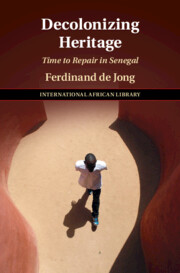Book contents
- Decolonizing Heritage
- The International African Library
- Decolonizing Heritage
- Copyright page
- Dedication
- Contents
- Figures
- Acknowledgements
- Prologue
- Introduction
- 1 History and Testimony at the House of Slaves
- 2 The Door of Return
- 3 Shining Lights and Their Shadows
- 4 Prayer of Emergency
- 5 Recycling Recognition
- 6 Ruins of Utopia
- 7 The Museum of Black Civilizations
- Coda
- Bibliography
- Index
- The International African Library
7 - The Museum of Black Civilizations
Race, Restitution, and Repair
Published online by Cambridge University Press: 10 March 2022
- Decolonizing Heritage
- The International African Library
- Decolonizing Heritage
- Copyright page
- Dedication
- Contents
- Figures
- Acknowledgements
- Prologue
- Introduction
- 1 History and Testimony at the House of Slaves
- 2 The Door of Return
- 3 Shining Lights and Their Shadows
- 4 Prayer of Emergency
- 5 Recycling Recognition
- 6 Ruins of Utopia
- 7 The Museum of Black Civilizations
- Coda
- Bibliography
- Index
- The International African Library
Summary
In 2019, the Museum of Black Civilizations was inaugurated by President Macky Sall. The concept for this museum had been launched by President Senghor during the First World Festival of Negro Arts in 1966. More than 50 years later, the museum finally opened its doors. Its timely opening made headlines across the world as it coincided with a global debate on the restitution to the countries of origin of objects illicitly acquired under colonial rule. Funded by the Republic of China, the Museum of Black Civilizations offered itself as a recipient for the restitution of 100 objects collected on Senegal’s territory. This chapter discusses the realization both of Senghor’s concept for a museum of Black Civilizations in the twenty-first century and of a project for the recuperation of African civilization. Through an analysis of its programme and exhibitions, the chapter examines how the museum decolonizes the concept of the museum by focusing on its exhibition of Abrahamic religions, as well as on the sabre of El Hadj Oumar Tall, an object that the Restitution Report advised should be a priority for return. Analysing the museum’s politics of restitution and repair, it frames the museum’s concept of Blackness as a technique to repair the legacies of race science.
Keywords
- Type
- Chapter
- Information
- Decolonizing HeritageTime to Repair in Senegal, pp. 211 - 244Publisher: Cambridge University PressPrint publication year: 2022

